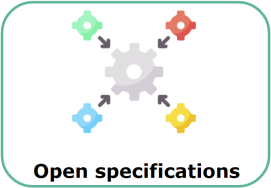Table of contents
- Open specifications
- Controlled vocabularies
- Raising awareness activities
- Studies & Reports
- Technical Pilots
- Tools
- Training Material
For a high level overview of the service offering as well as case studies, we invite you to consult the handout of the Catalogue of Services Action.
Open specifications

The Catalogue of Services Action develops and maintains data specifications for describing public services. The Core Public Service Vocabulary Application Profile (CPSV-AP) captures the core concepts used to describe public services independently from their context (financial services, tax, water supply, ...).
Public administrations and service providers can therefore use this approach to describe their services and guarantee a level of cross-domain and cross-border interoperability at European, national, and local level.
The CPSV-AP has been created and is maintained by a Working Group composed of Member States and EU institutions representatives, experts, and academia in the field of semantic interoperability and open data. So far, 7 countries are compliant with CPSV-AP and 8 others are using CPSV-AP as inspiration to develop their own data models.
Controlled vocabularies
Controlled vocabularies are clearly defined lists of names and concepts that ensure proper understanding when used for labelling, indexing or categorising. Therefore, the controlled vocabularies allow to represent fundamental features of a concept in a fashion neutral way.
The Catalogue of Services Action analyses and recommends the use of external controlled vocabularies as part of CPSV-AP. When no standard or well-maintained controlled vocabulary exists, the Action creates its own recommended lists together with the community. Business and life events are examples of such controlled vocabularies. More recently, the Action has proposed an initial classification of public services.
Raising awareness activities
The Catalogue of Service Action regularly organises various events to raise awareness about the services that can be provided to Member States. These events can take the form of webinars or workshops where we showcase our solutions in an interactive way.
Out of the 197 people who are members of the Working Group, we observe an average participation of between 50 and 100 people at our events (webinars, workshops, conferences, etc.). During our previous webinar in December 2020, we observed that 83 members participated for instance.
Studies & Reports
The Catalogue of Service Action commissioned reports and studies aimed at shedding light on the synergies made possible through the use of the CPSV-AP data model with different technologies in the public administration’s context.
A first study looks at how public administrations should go about automating data exchange using APIs and what important considerations need to be factored in.
A second study explores how citizens and businesses can best interact with public administrations to access information on public services via chatbots. Such chatbots would benefit from making use of machine readable data models.
A third study identifies how a commonly agreed taxonomy of generic public services could be implemented to help public administrations harmonising their catalogues of services.
Technical Pilots
Piloting activities have been undertaken in order to test and improve the tools developed by the Action.
These tools form the basis for pilots in several Member States designed to show the benefits of using interoperable solutions in managing public service descriptions as well as the value of technology in facilitating their harmonisation. Setting up and executing pilots is imperative for demonstrating the benefits and value of these solutions in real-world contexts. In addition, by implementing them in a variety of countries and environments, we are able to demonstrate the reusability, adaptability, and scalability of our solutions.
The pilots have demonstrated the value of the tools, offering clear and, tangible results of the Catalogue of Services Action, showing how they help deliver greater interoperability and more efficient exchange of information between Member States. In addition, by providing technical support, this Action helps support Member States in improving their underlying systems.
A previous pilot activity aimed at implementing a user-centric portal where public service descriptions from Estonia and Finland are available in a harmonised and user-friendly format.
Tools
To facilitate the creation, validation, harvest, and exchange of public service descriptions, 4 different tools have been developed by the Catalogue of Services Action as open source proof-of-concepts. Please note that there is functional and technical documentation for each tool also available on GitHub.
The Public Service Description Editor is a content management system that allows public administrations to create and manage CPSV-AP descriptions of public services.
The Public Service Description Harvester allows public administrations to obtain the data faster and more efficiently, easing creation of an integrated view on life & business events and public services provided within a specific country or region.
The Public Service Description Creator is a web form where public administrations can create CPSV-AP descriptions of public services in a fashion that is user-friendly and intuitive.
CPSV-AP Data Validator allows you to check whether your public service descriptions meet the requirements of the CPSV-AP.
Training material

